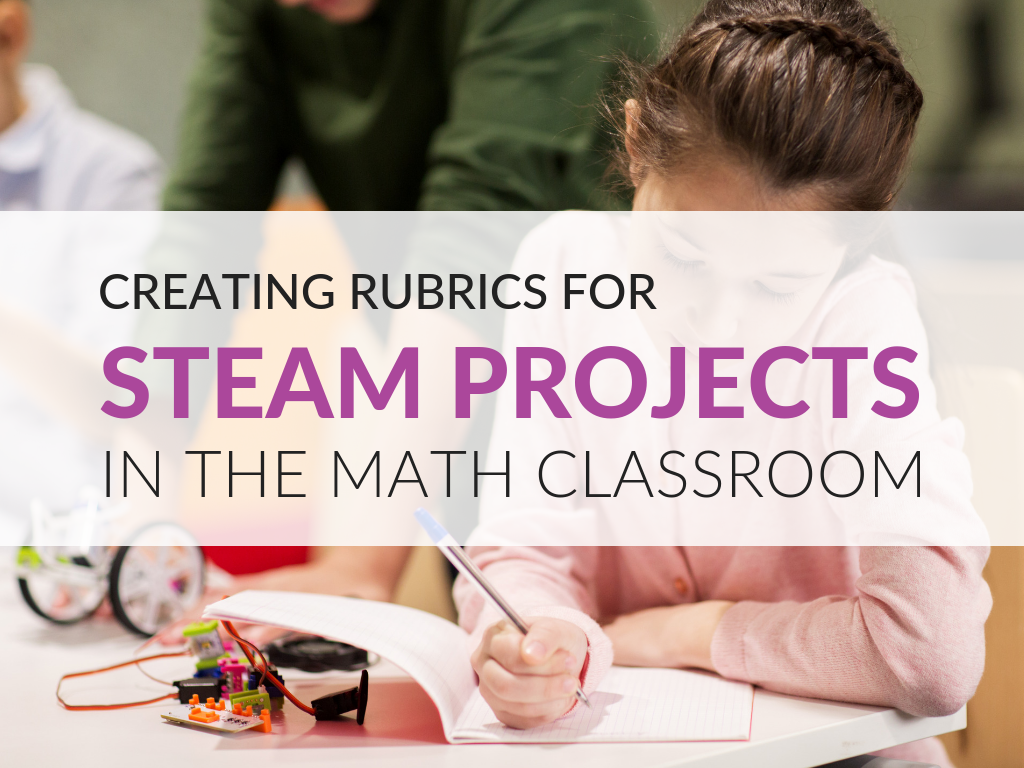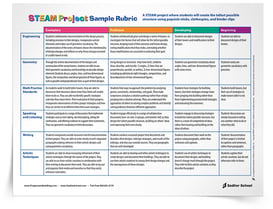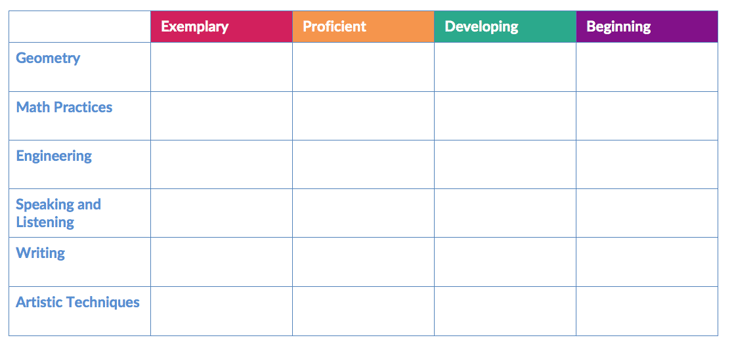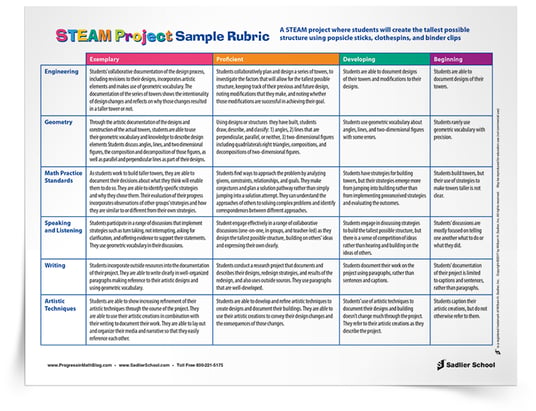October 8, 2018 k-2-math-practices, 6-8-math-practices, 3-5-math-practices
How to Create Rubrics That Will Enhance STEAM Projects in the Math Classroom
By: Jeff Todd
STEAM projects are interdisciplinary units. Like any good unit, they should use backwards design principles. When we are clear about the outcomes of the unit, we can plan supporting activities and ongoing assessment in order to be sure that students are using the project to achieve the intended learning outcomes. To do this, I want to walk you through how I developed rubrics for a Grade 4 math STEAM project where the goal is to build the tallest tower possible, using only Popsicle sticks, clothespins, and binder clips. Plus, download my free STEAM Project Sample Rubric for K–8 classrooms.

A few years ago, we wanted to start a robotics club in our school. When I say we, I mean the school’s students, parents, and administration. While all the teachers thought it was a good idea, there was one big question—who was going to step up to the plate to lead the effort? None of the faculty had ever built a robot, never mind teaching a student to do so! As a result, I volunteered to start the robotics club with the understanding that I would have to learn along with the students.
And that idea is what I want to share with you today about implementing STEM and STEAM projects in your school. You might have to be the courageous one who steps up to the plate. You may feel like you are putting yourself in an uncomfortable position because you have never done anything like it before. I can assure you that modeling for your students how to face open-ended challenges is one of the most valuable things you can do for them! They and you will benefit, even if is a bit uncomfortable for you at first.
Becoming the “guide on the side,” rather than the “sage on the stage,” is an idea that has been around since at least the 1980s, but has been popularized since the 1990s. When you decide to implement STEAM projects in your classroom, it is a unique opportunity to put this into practice for yourself. Becoming that guide on the side does not diminish the role of the teacher, but it can seem scary to us when we encourage students to become self-directed in their learning. I always have a couple of concerns about these open-ended projects. First, I think about how I can give students advice on topic that they choose and that I know nothing about. Second, if I am not explicit and intentional, students may not connect their STEAM project to the intended learning outcomes.
Engaging Reluctant Learners Through STEAM Projects
Ellen Edmonds, the Executive Director of Professional Development at Sadlier School, recently hosted a webinar about engaging reluctant learners through STEAM connections. Ellen's webinar, available for free on the Sadlier website, outlines best practices for STEAM projects. Here are some of my favorite points from the webinar. Below are some of Ellen's best practices for incorporating STEAM connections.
STEAM lesson needs to accomplish the following:
- Helps students apply math and science content through authentic, hands-on learning
-
Includes the use of (or creation of) technology
-
Involves students is using an engineering design process
-
Engages students in working in collaborative teams
-
Appeals equally to girls and boys
-
Reinforces relevant math and science standards
-
Addresses a real-world problem
Teachers should taking the following steps in order to engage students:
- Present a challenge
-
Indicate the usefulness of a topic
-
See math everywhere
-
Let math leak into other topics
Choosing the Standards to Develop STEAM Rubrics
 After watching Ellen's webinar I was inspired to create a STEAM project around building structures. For my STEAM project, I chose to focus on decomposing and composing geometrical figures for my math standards. I am assuming that students have a strong exposure to this first, and that I will be able to see their ability to apply it to through this project.
After watching Ellen's webinar I was inspired to create a STEAM project around building structures. For my STEAM project, I chose to focus on decomposing and composing geometrical figures for my math standards. I am assuming that students have a strong exposure to this first, and that I will be able to see their ability to apply it to through this project.
To begin planning my STEAM project for Grade 4 students, I had to select the content standards on which my rubrics would be based. When selecting content standards I usually look at state or national standards for the grade level across several disciplines. For STEAM projects in particular, I consider math standards, science and technology standards, listening and speaking standards, writing standards, and art standards. One thing from Ellen’s webinar that helped me in my thinking was the idea that STEAM projects reinforce, rather than teach, these standards.
For my Grade 4 STEAM project, I selected the following standards:
Math Standards
The principal goal of Grade 4 geometry is to draw and identify lines and angles, and to classify shapes by properties of their lines and angles. By building the tallest structure using Popsicle sticks, students will have ample opportunity to sketch, document, and describe their designs. As they discuss design features that can make a structure taller, they should be able to use their math vocabulary and ideas about parallel lines, right angles, and triangles.
The specific Common Core math standards of interest are: 4.G.A.1: Draw points, lines, line segments, rays, angles (right, acute, obtuse), and perpendicular and parallel lines. Identify these in two-dimensional figures; 4.G.A.2: Classify two-dimensional figures based on the presence or absence of parallel or perpendicular lines, or the presence or absence of angles of a specified size. Recognize right triangles as a category, and identify right triangles.
Math Practice Standards
For this STEAM project I chose Math Practice 1: Make sense of problems and persevere in solving them. Specifically within this standard, I want to focus on the idea that “mathematically proficient students start by explaining to themselves the meaning of a problem and looking for entry points to its solution. They analyze givens, constraints, relationships, and goals. They make conjectures about the form and meaning of the solution and plan a solution pathway rather than simply jumping into a solution attempt... They monitor and evaluate their progress and change course if necessary.”
Science and Engineering Practices
The Next Generation Science Standards provide practice standards for grade spans. The focus for this STEAM project could be: 3-5-ETS1-3: Plan and conduct an investigation collaboratively to produce data to serve as the basis for evidence, using fair tests in which variables are controlled and the number of trials considered.
Please notice that the word “collaboratively” is part of the standard. This serves to underscore that students need to work together on these projects and as a result this will lead to the use of listening and speaking standards from English Language Arts.
ELA Standards
I would focus on writing and listening and speaking standards for this STEAM project. For writing, standard W.5.7: Conduct short research projects that use several sources to build knowledge through investigation of different aspects of a topic. Students will need to write about their project that will include their own work of designing and building as well as other sources.
For speaking and listening standards, SL.4.1: Engage effectively in a range of collaborative discussions (one-on-one, in groups, and teacher-led) with diverse partners on Grade 4 topics and texts, building on others' ideas and expressing their own clearly.
ART Standards
The National Core Arts Anchor Standards guide educators in providing a unified quality arts education for students Pre-K through high school. Anchor Standards 5 and 6 provide the basis for including graphic arts as an element of this STEAM project. Students will develop and refine artistic techniques and work for presentation, and convey meaning through the presentation of artistic work. In this case the artistic work can be used as a way to document students’ design plans and actual constructions. They then use their artistic works to communicate about the design process including the use of their mathematical vocabulary.
Establishing the Criteria for Success Through the Rubrics
Having chosen the math, science/engineering, ELA, and art standards relevant to the STEAM project, I am better able to articulate the goals of the project.
Students will build the largest tower possible using Popsicle sticks, clothespins, and binder clips. They will collaborate in order to develop techniques for documenting their designs and buildings with the goal of refining their designs and describing design elements using geometric vocabulary.
Having focused the project towards specific standards, I then constructed the rubrics using a grid. I used the categories of exemplary, proficient, developing, and beginning. Those categories appear across the top of the rubrics table while the content standards appear in the right column. The end result looks like this.

It is easiest for me to first complete the proficient column using language from the standards. Exemplary rubrics are developed by explaining how students can combine the proficient-level standards between topics (such as combining artistic techniques with geometry) to demonstrate how those standards can be integrated as students apply their knowledge to the STEAM project.
To write the developing rubrics, I think about how students might partially, but not completely, meet the standard. Beginning rubrics show how students can show evidence that have made the first steps toward meeting the standard. Sometimes I look at prior knowledge standards for the beginning indicators.
Download the full rubric for this STEAM project. This rubric is an exemplar to guide you in the development of STEAM rubrics.
In Summary
STEAM is a movement within education to give students authentic opportunities to solve problems using math, science, engineering, arts, and technology.
Planning with the end in mind, or using backwards design, is one of the strategies teachers can utilize to make sure STEAM projects are effective. This strategy of planning with the end in mind will ensure students connect STEAM projects with intended learning outcomes. To clearly define the intended learning outcomes, begin STEAM planning by choosing content standards on which to construct rubrics.
Remember, STEAM projects are interdisciplinary units. By engaging your colleagues and teammates from other disciplines, you can develop a set of rubrics that will help you and your students know what success looks like. I think it is helpful to have an activity in mind when you begin, but remember that it should be the standards rather than the activities that drive the development of the lesson.




